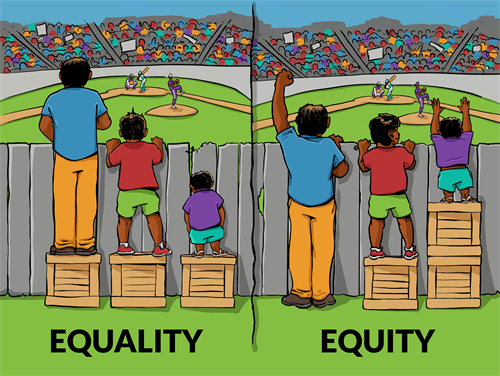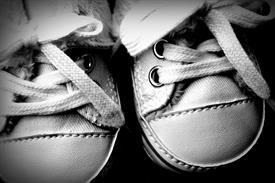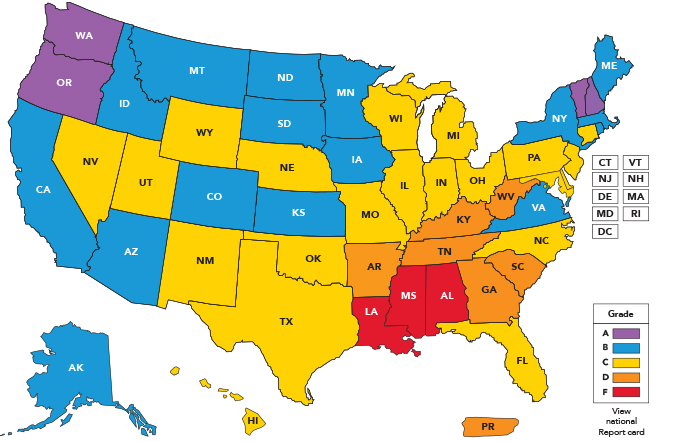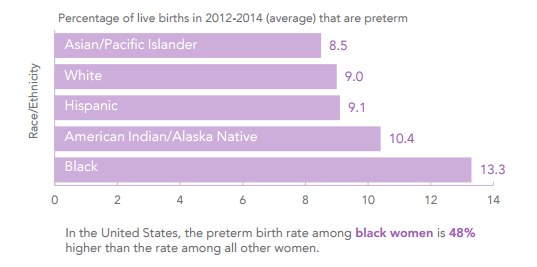ATTENTION:
WE ARE HOSTING OUR UPCOMING MEETING!
ALL ARE WELCOME TO ATTEND!
Friday, December 2, 2016
Time: 12PM to 2PM
Location: JFK Library (505 Santa Clara St, Vallejo)
JOSEPH ROOM
Lunch is provided!

Defining Equity
Cynthia Silver Parker, Senior Associate of the Interaction Institute for Social Change, explained it best when she said, "In the simplest terms, equity means fairness, which is not necessarily the same as equality. It's not about everybody getting the same thing. It's about everybody getting what they need to improve the quality of their situation".1 The illustration by Angus Maguire above, a modification of the popular original illustration by Dr. Craig Froehle, provides a clear picture of the difference between equity and equality.
Inequities are created when barriers prevent individuals from reaching their full potential.2 These barriers can be social, economic, demographic or geographic. It has been concluded that the route to achieving equity will not be accomplished by treating everyone equally. It will be achieved by treating everyone equitably, or just according to their circumstances.3
CityMatCH is a national organization of city and county departments' maternal and child health programs and leaders representing urban communities in the United States.
CityMatCH aims to strengthen public health leaders and organizations to promote equity and improve the health of urban women, families, and communities. CityMatCH provides technical assistance for cohort members of the Institute for Equity in Birth Outcomes, a national initiative designed to strengthen the scientific focus and evidence base for realizing equity in birth outcomes in urban U.S. cities.
Solano County is honored to be the only West Coast participant in the most recent cohort. Over the next two years, representatives from county departments and community-based organizations in Solano County will select, implement, and evaluate a project which addresses equity in birth outcomes of Solano County residents. Community members of all backgrounds and expertise are encouraged to participate in project activities.
Current participants: Solano County Department of Health & Social Services
About Birth Outcomes
INFANT MORTALITY

Infant mortality is defined as the "death of an infant before his or her first birthday". Recent national data reports over 23,000 infant deaths in 2014.4
Possible causes of infant mortality include: birth defects, pre-term birth (delivery before 37 weeks), low birth weight (less than 5 lbs, 8 oz), pregnancy complications, Sudden Infant Death Syndrome (SIDS), and trauma/injury.4
Preventing infant mortality:
Centers for Disease Control and Prevention
World Health Organization
NIH Safe Sleep Campaign
NICHD Research
American Congress of Obstetricians and Gynecologists (ACOG)
Supporting families who suffered tragic loss:
CJ Foundation for SIDS
Compassionate Friends
First Candle
March of Dimes
M.I.S.S. Foundation
Share Pregnancy & Infant Loss Support
Maternal Child and Adolescent Health Bureau Toll-Free Line
(877) 680-2229
PRETERM BIRTH
When a baby is born too early, their birth is "preterm" or "premature". Preterm or premature birth affected 1 out of every 10 infants born in the United States in 2015.5
A developing baby goes through important growth processes throughout a pregnancy, including in the final weeks and months. For example, the baby's brain, lungs and liver fully develop in the final weeks of gestation. However, if a baby is born too early (defined as less than 37 weeks gestation), the infant is at higher risk for serious disability and/or death. Infants who are born too early and survive may develop breathing problems, feeding difficulties, cerebral palsy, development delay, vision problems, and hearing impairment.5
The March of Dimes is an organization that was initially established in 1938 by President Franklin Delano Roosevelt to resolve the polio epidemic and has since shifted its focus on improving the health of babies by preventing birth defects, premature birth and infant mortality. The March of Dimes released the 2016 Premature Birth Report Card, which indicates that the U.S. preterm birth rate in 2016 was 9.6%.6
The image below grades preterm birth rates by state, with the best ranked as A and worst ranked as F. California received a grade of B, which indicates a preterm birth rate range from 8.2 to 9.2%. Recent data from the California Department of Public Health shows that Solano County has a preterm birth rate of 8.5%.7

Race & Ethnicity Disparity in Preterm Birth
The March of Dimes reports that the preterm birth rate among African American women is 48% higher than the rate among Asian/Pacific Islanders, Caucasian, Hispanic/Latino, and American Indian/Alaska Native women combined.7

To view the March of Dimes' 2016 Premature Birth Report Card, click here.
Prematurity Campaign
The March of Dimes launched their Prematurity Campaign in 2003 in order to address the crisis of premature births and to help families have full-term, healthy babies in the United States. In 2008, their efforts expanded to include global campaigns.
November 17th is internationally recognized as World Prematurity Day.
LOW BIRTH WEIGHT
A baby's weight at birth is a strong indicator of maternal and newborn health and nutrition. Undernourishment in the womb increases risk of death in the early months and years of a child's life. Survivors have increased risk of impaired immune function and disease. Prolonged undernourishment can lead to reduced muscle development and cognitive abilities throughout their lives.8
Low birth weight is indicated by birth weight less than 2,500 grams (or 5 lbs, 8 oz). The Centers for Disease Control and Prevention reports 8% of all infants born in 2014 had low birth weights.9 In particular, 6.7% of all infants born in California in 2014 had low birth weights.10
Smoking, poor nutrition, poverty, stress, infections and violence can increase the risk of a baby being born with a low birth weight.10 Additional risk factors include race, age, multiple births, illicit drug use, and alcohol use.11
Possible causes of low birth weight include premature birth and/or fetal growth restriction, which can be affected by both birth defects and infections.11
Preventing low birthweight:
March of Dimes
The National Academies Press (Free PDF download!)
Meeting Agendas & Notes
NEXT MEETING:
Friday, December 2, 2016
12 to 2PM
JFK Library (505 Santa Clara St, Vallejo)
Joseph Room
Agendas:
Birth Outcomes Equity Project - Meeting Agenda DEC 2016
Notes:
Birth Outcomes Equity Project - Meeting Notes JULY 2016
Birth Outcomes Equity Project - Meeting Notes AUG 2016
Birth Outcomes Equity Project - Meeting Notes SEPT 2016
Birth Outcomes Equity Project - Meeting Notes OCT 2016 (Coming soon!)
Birth Outcomes Equity Project - Meeting Notes NOV 2016 (Coming soon!)
Resources
AMCHP Infant Mortality Toolkit
Making Data Talk: A Workbook
RWJF's "A New Way to Talk About the Social Determinants of Health
Upcoming Events
World Prematurity Day
Thursday, November 17, 2016
Birth Outcomes Equity Meeting
JFK Library (505 Santa Clara St, Vallejo)
Friday, December 2, 2016
12PM - 2PM
JOSEPH ROOM
Kirwan Institute for the Study of Race and Ethnicity Webinar Training
Wednesday, January 18, 2017
12PM - 1PM
Kirwan Institute for the Study of Race and Ethnicity will introduce participants to implicit bias and its impact on our society in preparation for a longer training at their 2017 Equity Institute Training (date and location TBD).
Presenters:
Robin Wright, Researcher & Facilitation Specialist
Lena Tenney, Researcher & Facilitation Specialist
Key Learning Objectives:
Basic understanding of key elements of our social cognition
General facility with the impact of our implicit associations on our actions and decisions
Motivation and tools necessary to mitigate the effects of harmful bias To Access the Call:
Log in here
Dial 1-866-740-1260
Access code: 5529591
Contact Us
Are you concerned about a particular inequity in your community?
Do you have ideas on how to bring equity to your community?
Do you represent a community-based organization which directly or indirectly addresses an inequity in your community?
Are you interested in joining the collaborative efforts of the Birth Outcomes Equity Project?
Contact Susan Whalen at SWhalen@SolanoCounty.com or (707) 784-8397.
Sources Cited:
1. Cynthia Silva Parker, Senior Associate for Interaction Institute for Social Change
2. American Public Health Association, 2016
3. Race Matters Institute, 2016
4. http://www.cdc.gov/reproductivehealth/maternalinfanthealth/infantmortality.htm
5. http://www.cdc.gov/reproductivehealth/maternalinfanthealth/pretermbirth.htm
6. https://www.cdph.ca.gov/programs/mcah/Documents/2000-2013%20Preterm%20Birth%20Rates%20%E2%80%93%20with%202013%20County%20data.pdf
7. http://www.marchofdimes.org/materials/premature-birth-report-card-united-states.pdf
8. http://data.unicef.org/topic/nutrition/low-birthweight/
9. http://www.cdc.gov/nchs/data/nvsr/nvsr64/nvsr64_12.pdf
10. http://datacenter.kidscount.org/data/tables/5425-low-birthweight-babies?loc=1&loct=2#detailed/2/6/false/869,36,868,867,133/any/11985
11. http://www.stanfordchildrens.org/en/topic/default?id=low-birthweight-90-P02382